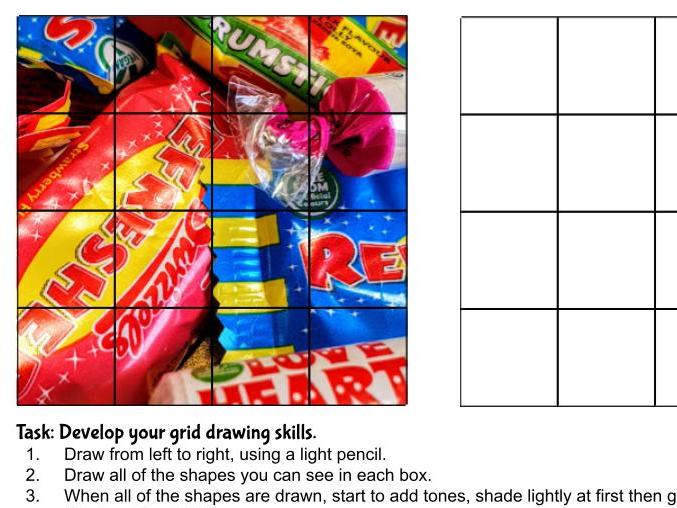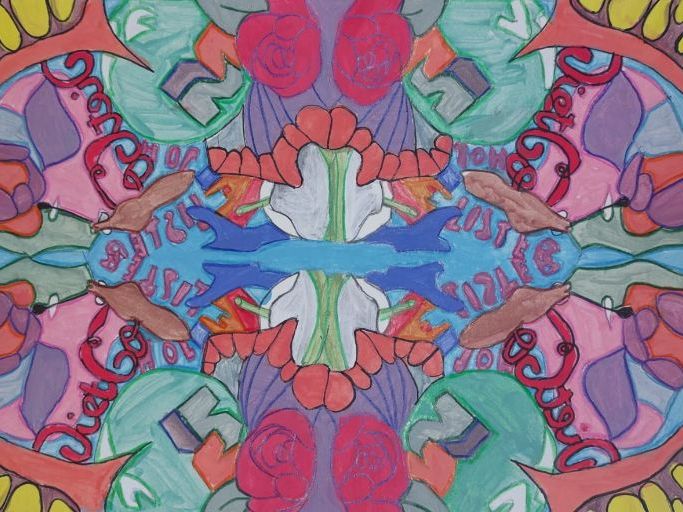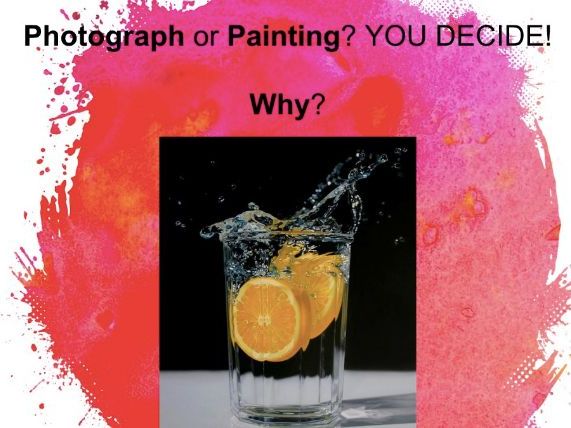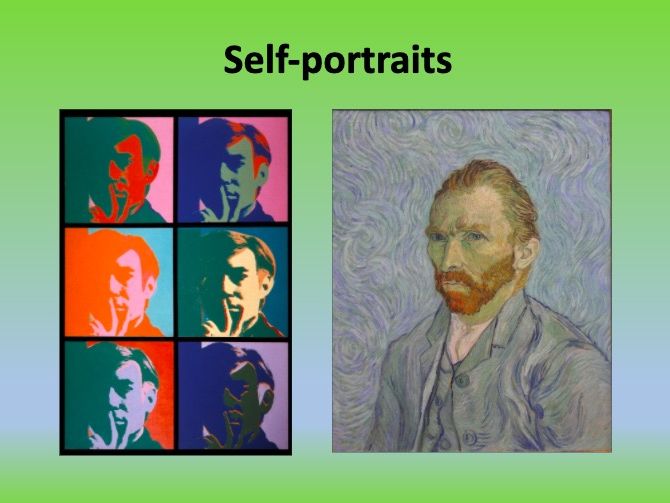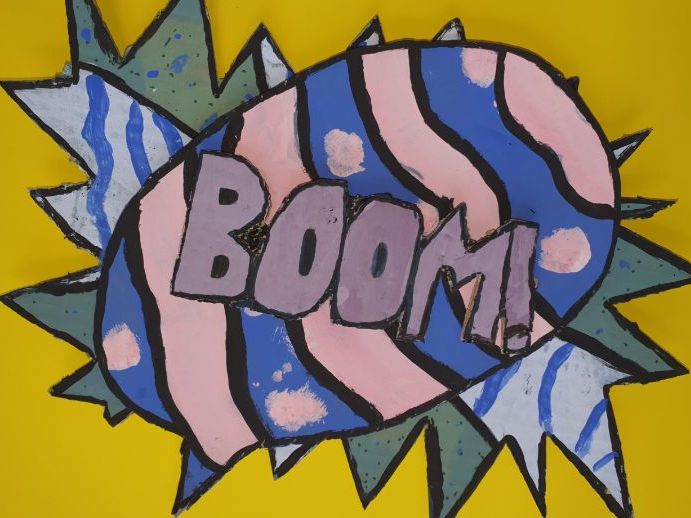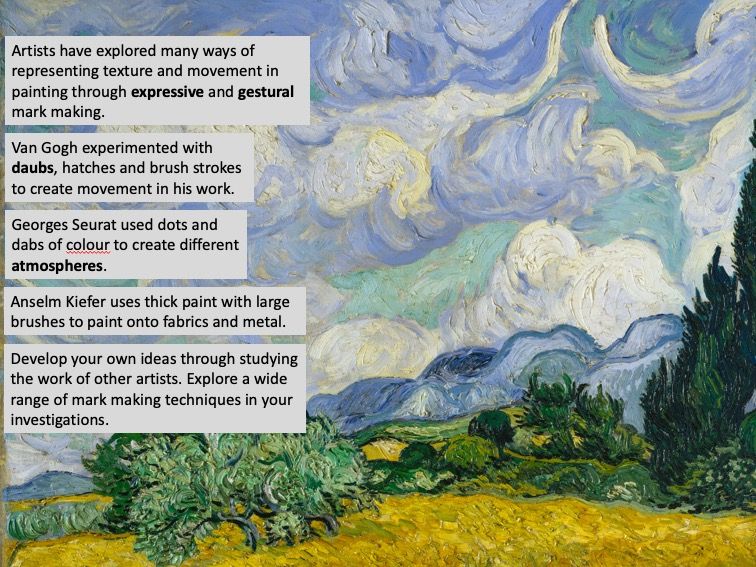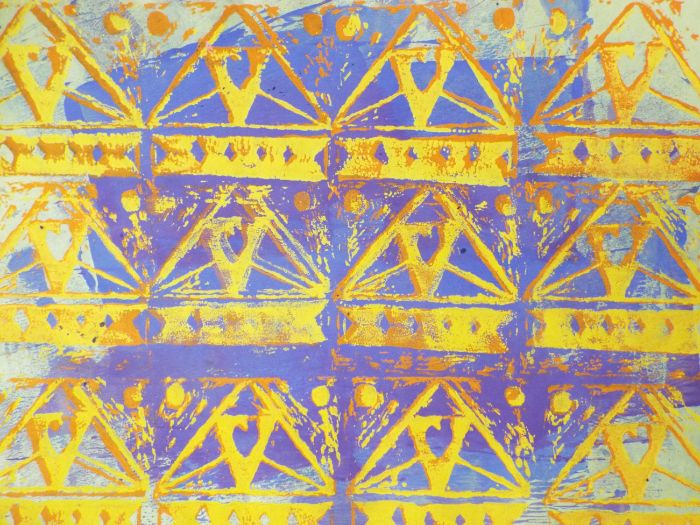
33Uploads
54k+Views
10k+Downloads
Art and design

Grid Drawing Worksheets. 70+ slides for cover or extension tasks
This Grid Drawing presentation has over 35 different pictures for students to choose to draw from. Each picture has an ‘easy’ and ‘hard’ version so there are over 70 slides in total for you / students to choose from. Each slide can be printed to give out as a Grid Drawing worksheet, ideal for cover / sub lessons or extension tasks.
The images are all high res so each slide can easily be printed to A4, then blown up on the copier (if needed). There is a huge range of themes:
Sweets, Cake, Fruit & Vegetables, Flowers, Architecture, Tools, Cutlery, Facial Features like eyes, mouth and ears, Fists, Animal textures, reptiles, fish etc. Lego and toys.
I have tried to make the task as accessible to all students as possible, so some images are more complex and some are more simple. On the ‘easy’ version of each picture, there is a very light copy of the image for students to draw directly over if they are struggling with the blank grid.
The task instructions are written at the bottom of the sheet and there is room for students to write their name on the sheet.

KS3 Art Pattern Painting Project - William Morris inspired
This full pattern painting scheme of work is inspired by artist William Morris. There are over 70 slides on the presentation, and it goes through many aspects of creating a repeated reflection design using tracing paper.
The project introduces students to the work of William Morris, different types of pattern repeats and colour theory. It builds on basic colour theory and introduces secondary, tertiary, monochromatic, analogous and complementary colour schemes. The presentation includes a slide explaining the project aims and each lesson has clear tasks set.
The projects is designed to build students’ skills in painting each lesson, with all lessons having starter / entry tasks and plenaries included. There are lots of examples of high quality student work at each stage of the project. There are also challenges included and printable resources (slides with white backgrounds so they are easy to print and copy) to use in the lessons.

KS3 Art and Textiles Hand Embroidery Project
This simple textiles art project is ideal for teaching younger students as it is really short but engages students by giving them lots of choice in their work. Students love the bright colours, the different shaped stitches and, of course… the sweet, sugary subject!
Students learn basic hand stitches: running, back, chain, French knot and have the option to learn more if they can.
The outcomes are so fun and students loved using the felt tips on the fabric. The presentation includes lesson starter activities, plenaries, reflections etc. and breaks down the steps into really simple to follow instructions. There are links to appropriate artists and links to free handouts to use too.

GCSE Art Skills Training Project - Pop Culture
This GCSE Art Project aims to develop and enhance the range of skills that students have been taught at KS3, enabling them to master and improve in a way that was engaging yet simple to achieve. There are some ‘essential’ art skills taught in this project, including: grid drawing, pencil drawing, pen drawing, acrylic painting, watercolor painting, poly printing and different types of research / art analysis / presentation skills.
The theme is Pop Culture, allowing students a wide range of references to work from.
The presentation includes lesson entry tasks / plenaries and exit tasks, examples of student work, homework tasks throughout.
There are printable resources on slides 1-12 with the Pop Culture images I used in lessons. There is an artist research information slide that can also be printed (slide 43)
There are 124 slides in total.

KS3 Easy Clay Vessels Project & Colour Theory
This is a simple but effective clay project that I teach with Year 9, but could be any KS3 / KS4 project. The outcomes are excellent and I have found it even keeps Y9 boys engaged…
This is a full scheme of learning which introduces various techniques for clay work, including incising and applying, contructing, building etc. The project looks at different artists and their work, then asks students to design their own vessel based on underwater textures. The are opportunities for cross-curricular learning etc.
The clay vessels are simple to build, and there are clear steps and instructions showing students how to. Before students build their final piece, there are lessons teaching them to use various clay tools on a simple slab in order to master incising into the clay and applying clay onto clay. Therefore students end up with two pieces of work, one ‘practise’ piece and one ‘final’ piece. This allows time for one to be fired / painted while the other is drying.
The end of the project introduces some basic colour theory, looking at harmonious colours, accent colours, tints and shades. We painted our vessels using acrylic but you could easily change how you paint / decorate yours.
The scheme of learning includes all of the slides I used over a series of 6 - 7 weeks. Entry tasks, starters, mini acitivities, peer assessment, self assessments, plenaries etc. are all included. The materials I used are just clay and blue carving tools. Students mixed their own slip after I showed them how to.

Effective Starters & Plenaries for Art and Design
I have created a huge PowerPoint presentation with over 45 starter or plenary activities for your art classes.
The activities are all art-related and can be used in KS3 or KS4 art lessons, either as entry tasks, starters, plenaries or exit questions. Sometimes I put the question on the board at the start of the lesson then come back to it at the end.
The slides are made up of questions, challenges, thought prompts, image analysis, riddles, true or false competitions, thunks and more. Some are very general so can be used across any class or topic, and some are more specific and related to different art movements - for example, Pop Art or Graffiti.
You can use the slides to generate discussion or have students discuss things in groups/pairs etc. I have made them to be as adaptable to your lessons/teaching as possible.

Drawing portraits: KS3 art scheme of work
A full scheme of work covering all of the basics in drawing realistic portraits. Aimed at KS3 art students, I usually teach this with Year 7.
The powerpoint includes nearly 50 slides, including a quick history of portraiture. It breaks down drawing all of the facial features into easy to follow steps. Each lesson has an entry task/starter activity, challenge and homeworks are included. There are examples of students’ work, as well as links to easy to follow videos.
The scheme of work can be easily adapted and I have tried to make it really simple to follow.

3D Pop Art & Colour Theory full scheme of work using cardboard and paint
I designed this 3D Pop Art project as a fun way to end the summer term with my students. It is inspired by different Pop Art ideas and I combined a few elements of art (including colour theory) to create this full scheme of work. I taught it with Year 7 (11-12yrs) for around 6 weeks, having one hour lessons per week - though I think it could easily be adapted for different ages too!
The 3D Pop Art project was designed to be a fun way to introduce students to some of the basic elements of Pop Art; bright, flat colours, use of line and outline to create comic styles, pattern and the importance of language and text, specifically onomatopoeias. I wanted students to develop their understanding of colour theory too, so added some challenges for colour mixing and use of colour schemes.
The project includes starter activities, plenaries, reflection tasks etc. and anything that can be printed is included on the slides. There are 34 slides in total.

GCSE Art Scheme of Work - The Blue Planet
This is a full GCSE scheme of work for a project based on The Blue Planet.
It covers all four assessment objectives and explains to students how they can achieve different grades. It guides them through their presentation and gives examples of different levels of work.
The project includes slides for entry tasks / starters / plenaries etc and has a full range of artists’ work to show. The lessons are planned out as I used them, however you can easily remove or change etc. any slides you want to.
There are 87 slides in total.
This project could easily be adapted for Natural Forms, Pollution or similar themes. It explores:
AO1 - research. It shows examples of excellent research design sheets and sketchbooks
AO2 - experimentation. It includes a wide range of experiments and ideas for students.
AO3 - annotations and design ideas. There are a range of examples of how to annotate work and various ideas for final pieces.
AO4 - final designs. It clearly explains to students what they need to do to reach different grades and marks for their final pieces.
You can read more about this GCSE Art full scheme of work here.

GCSE Art Scheme of work - landscape and mark-making project
The aim of this project was for students to explore a range of mark making techniques, then choose the most suitable for their landscape ideas.
The outcomes were painted (and printed) landscapes, focusing on movement, atmosphere and texture. The brief was:
Many artists are inspired by landscapes. Some draw or paint from direct observation, others create pieces from memory. Research relevant artists, looking at how they create movement and different atmospheres in their work. Develop mark-making techniques then produce a final outcome based on a landscape you have happy memories of.
Students started by looking at artists such as Van Gogh and Georges Seurat.
This project includes all of the lessons I used, including starter activities, plenaries, assessments etc. It includes over 40 slides.
It has a range of artist research starting points and teaches a large range of techniques including, pointillism, dry brush, monoprinting, collage, painting with glue, impasto, textures etc.

GCSE Art 'Objects' project - full scheme of work
This is a full GCSE art presentation for a coursework project with the theme ‘objects’ or ‘still life’.
Objects was a previous starting point on the AQA ESA so I used it as a coursework project too.
The presentation covers:
research, experimentation, refining work and developing final ideas
all of the AQA assessment objectives for GCSE art
different types of research including artist, primary and secondary
a range of experiments including grid drawing, drawing with charcoal, painting with acrylic, drawing with felt tips, lino reduction printing, and photography techniques
different artists and how they respond to the theme ‘objects’
how to develop ideas by combining materials / planning final outcomes
There are 95 slides in total.
There are entry tasks / exit tasks / homework tasks and lesson tasks for each of the techniques.
There are also student examples throughout the presentation and notes on some slides to explain what I was doing with my classes.

GCSE Photography Grade 9 Exam Example Project
This is a GCSE Photography project which achieved a Grade 9 on the AQA exam board. The project is from the Externally Set Exam (ESA) for the ‘Fragments’ question.
It was completed on PowerPoint / Google Slides (not printed into sketchbooks) and edits were done on Photoshop - if you don’t have photoshop they can be done online at photopea.com There are some ‘physical edits’ which were printed in school.
The photographs were taken on the student’s phone.
The project shows how to meet all of the Assessment Objectives successfully and fully - from research, to experiments, refining ideas and presenting final pieces. You could use it as a template to show other students if you wish.

KS3 Art Easy 3D Project
I have found this 3D art project great for engaging boys in art as they get to use new tools and materials and it is really tactile! I marked on teamwork skills rather than ability and the project can be extended or shortened.
This is a full scheme of work asking students to build structures (from cardboard) based on architecture designed by Michael Wilford. Students work in groups to design then construct creative ‘buildings’ - from cardboard using minimal materials. They will need carboard, tape, glue guns (if you have them), craft knives.
I designed the brief around ‘vessels’ rather than buildings so students didn’t just build houses or blocks.
I taught this over a six week term but it can be shortened or extended easily. The project includes all of the entry tasks / starters, main activities and plenaries that I used.

Art Lesson - Drawing the Human Figure
This is a stand-alone art lesson that helps to teach students how to draw the correct proportions of the human figure. This is an introduction to figure drawing, which can be used in a bigger scheme of work looking at the human figure, or it can be used as a cover lesson.
This lesson can be used with KS3 or KS4 students and can be easily differentiated. It includes 3 main activities (starter - main - plenary) and can be taught by a non-specialist. It has clear learning objectives and an extension.
It encourages students to look carefully at the proportions of the human body.
I have made this lesson as I was unable to find a quick one-off lesson that was not just focused on drawing. This lesson has different activities to keep students engaged.
Any teacher would be able to deliver the lesson, you just need to make a photocopy of one of the resources attached to the PowerPoint.

KS3 Poly-Printing Art Scheme of Work
This art scheme of work is to teach the poly printing technique to students in a fun way. It is inspired by Adinkra symbols and includes all of the information you need to teach poly printing effectively, all of the start activities, entry tasks, plenaries, reviews / student assessments etc. It even includes cleaning up roles!
The full project includes a lot of information for lessons on colour theory and links to an artist (looking at creating textured backgrounds to print onto).
There are 30 slides in total and I have taught this project over 6 - 8 week term, but obviously you could shorten it if you need to. It includes examples of student work and teaches students to understand some basic pattern design.

Fun Art Assessment Ideas
A long list of different, fun and engaging assessement activities specifically design for art lessons. There are a range of formative and summative assessment ideas, as well as self-assessment tasks, peer-assessment activities and whole-class assessment ideas. All of the resources needed are included in the presentation. A fun way to jazz up the bog standard WWW / EBI.

KS3 Cubism Art Project using Oil Pastels (Plants and Flowers)
This is a full scheme of work teaching oil pastel techniques in a Cubist style. Students look at various Cubism techniques, and apply them to their own artwork - the subject matter is plants and flowers. I have created a full presentation with 30 slides that include starters, plenaries, mini tasks, challenges etc.
The presentation shows the steps of the oil pastel art project clearly from start to finish, with various differentiated outcomes and activities. It is simple to teach and the outcomes from my students (mixed ability Y9) have been really wonderful!
The subject matter is plants and flowers and I have found it engaging for my Y9 students - mainly because oil pastels provide instant gratification!

Abstract Still Life Painting Scheme of Work KS3
A KS3 painting project based on Abstract Still Life. This full project covers a series of lessons, teaching students about observational drawing, colour theory, pattern and mark-making and painting techniques.
It includes artist research, experimentation, developing ideas and final outcomes.
I have taught it with Y8 KS3 students, however it can be easily adapted for any year group. The project includes entry tasks / starters and plenaries / clear lesson outcomes and examples of students work at each stage.

Drypoint Etching GCSE Art Project
This is a full drypoint etching GCSE art project. It covers the four AQA assessment objectives and is based on the theme ‘Inside Out’. I have taught this project as a mini project but it could easily be extended or developed.
You need some basic equipment: printing ink, perspex (old CD cases work well) I got off cuts from the school DT department. A tool to scratch the perspex (anything with a sharp point works) and a printing press. If you don’t have a printing press, you can easily transfer the image using a wooden spoon or similar.
The project uses Leonardo da Vinci’s anatomy drawings as a starting point and asks students to look at his work then respond. I had students do observational drawings from skulls / bones from the science department.
I had students work on design sheets for this project but you could easily do the same in sketchbooks. Students create a series of observational drawings then use them, along with pictures of celebrities or inspirational people, to create ‘Inside Out’ portraits which show half a face and half a skull.
I have included steps for each stage of the processes, including drawing skulls, and videos (slides 18 and 20 - link is also in the notes) that show students what drypoint etching is and how to do it. The slides show clear instructions for students and I have also incuded examples of student’s work at each stage. Students create colourful, creative prints that they can work independently on once they know the process.
Students were asked to create test prints then a series of final colourful prints - I was really impressed with their outcomes!

Mark-making step-by-step video (painting with PVA glue) for KS4
A step-by-step video for KS4 pupils exploring mark-making. I used this to allow pupils to self-pace their lesson.
The video was made specifically for a Landscape project, but you can use it with other topics exploring mark-making.
I used this for one lesson at KS4, most pupils did not finish their piece in one lesson. Excellent for differentiation as pupils can stop, rewind and rewatch parts of the video if they need to.

